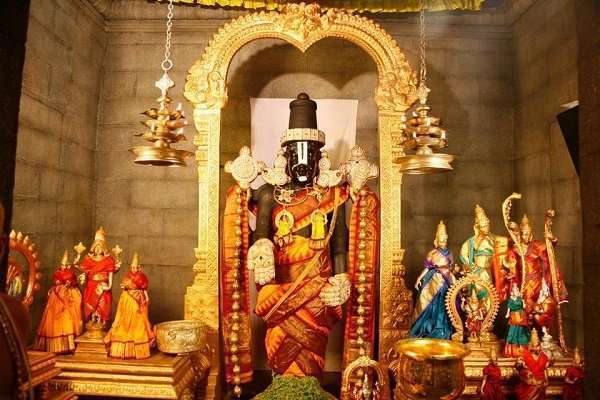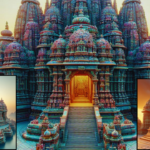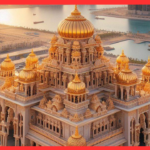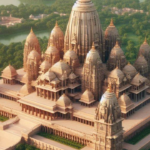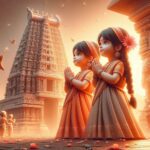Tirumala Temple
Hi All today I would like to write about the history of idols in Tirumala temple. There are five idols in Tirumala temple each of the models has its importance and history.
Importance
During our childhood, we were fortunate to get swami darshan much closer. In today’s times, the majority of darshans occur from a considerable distance, making it challenging for darshan. This is why I would like to write about the secrets of these five idols, also named Pancha Beras. Each of them carries a distinct energy and significance. By reading this article all can understand about the idols, which will help you connect with them more deeply when you visit them in the future.
Bhoga Srinivasa Murthy
Bhoga Srinivasa Murthy” is a special idol located at the feet of Lord Venkateshwara, also known as “Kouthuka Beram” or the “Idol of Joy.” This idol is one of the five idols referred to as “Pancha Beralu.” The connection between the main deity (Moola Virat) and “Bhoga Srinivasa Murthy” is deeply mystical and historic.
In 966 A.D., the Tirumala Sanctum was closed for renovation, leaving devotees disappointed as they couldn’t have the darshan of the Lord. However, Lord Venkateshwara appeared in a dream to Pallava Queen “Perundevi” (aka “Samavai”) and instructed her to place a two-foot-high silver idol in the sanctum. This silver idol of “Bhoga Srinivasa” was worshiped by devotees during the renovation period.
Near the feet of the main deity, there is a mystical geometrical form called “Jeeva Sthanam,” and the idol of “Bhoga Srinivasa Murthy” is always placed there.
A holy Golden/Silk thread connects the two idols, signifying their strong and everlasting bond. Bhoga Srinivasa Murthy receives daily rituals, such as “Sahasra Kalashabhisheka” and “Pavalimpu seva” (putting the Lord to sleep). Whenever the idol of Bhoga Srinivasa is brought out for these rituals, the thread connection is maintained. Observing this sacred thread during the sevas on TV can enhance the spiritual experience, reminding devotees of the profound connection between Bhoga Srinivasa Murthy and the main deity, making the rituals more meaningful and spiritually uplifting.
Koluvu Srinivasa Murthy
Now, let’s discuss the second deity, known as “Koluvu Srinivasa Murthy” or “Bali Beram.” This idol is placed to the left of the main deity and can be identified by the arch-shaped design with spikes on its outer corners.
Every day, following regular rituals like “Suprabhata Seva,” “Alankara Seva,” and “Thomala Seva,” “Koluvu Srinivasa Murthy” is seated outside the sanctum. Then, a golden umbrella is gifted to him by the Maharaja of Mysore, and the day’s almanac (thidhi, nakshatra) is read to him. Next, the income and expenditure of the previous day are presented to the Lord. This practice resembles how a king is updated on the state of affairs. As the “Akhilanda koti Brahmanda Nayaka” (master of infinite universes), he receives the services befitting a supreme emperor during the “Koluvu Seva.”
Priests also present the Lord with plans for the current and next day. Additionally, they read out the names of donors who are offering free Anna Prasadam (food) at Tirumala on that day. This is a fortunate opportunity, as our names are explicitly mentioned to the supreme lord and subsequently to the goddess Lakshmi. She blesses us with immense wealth in return for this pious deed. Thus, wealth should be used for benevolent purposes. Returning to the “Koluvu Seva,” after the update, the staff performing this ritual offer and take back food grains as prasadam. This act is akin to how a great emperor rewards his personnel, showcasing the Supreme Lord gracing his sevaks. Watching this seva, knowing its significance, feels like witnessing the greatest emperor presiding over his council.
Ugra Srinivasa Murthy
Now, let’s discuss the third idol, Ugra Srinivasa Murthy (Snapana Beram). It is situated on the left side of the Moola Virat and is accompanied by his consorts Sridevi and Bhoodevi. This idol served as the primary processional deity until 1330 CE.
In 1330 AD, a fire broke out in Tirumala during the Brahmotsavam festival when sunlight fell upon this idol. This incident is documented in the inscriptions of Tirumala, resulting in an abrupt halt to the Brahmotsavam. Concerned priests prayed to the Lord for guidance, and Lord Venkateshwara conveyed his divine order through a devoted follower. According to this divine order, the sun’s rays must never touch this idol, and it should always remain in the sanctum. The idol is only brought out twice a year—on Janmashtami and Ksheerabdi Dwadasi.
If you happen to visit Tirumala on one of these days, you can witness the procession of this deity around 2 AM along “Mada Veedhi,” which encompasses the four streets around the temple. The procession concludes before 3 AM, and the idols are returned to the sanctum.
It’s important to note that the term “Ugra” in Sanskrit means “fierce.” However, this does not imply that the idol appears fierce. “Ugraavataram” or ferocity, in this context, refers to one of the divine expressions or qualities of the Lord known as “Ugra Kala,” which is activated by sunlight. This ferocity should be understood as the Lord’s anger against evil and those who cause suffering to his devotees. Overall, the Lord is always compassionate and merciful towards his devotees.
Utsava Beram
The “Brahmotsavam” celebration was interrupted by a fire, and later resumed as follows: Lord Venkateshwara conveyed through a devotee that the deity “Ugra Srinivasa” should be replaced with a new idol discovered in the “Malayappa Kona” forest area in Tirumala hills. The temple staff promptly dug at the specified location and found a 3 ft tall idol of Lord Venkateshwara, accompanied by idols of his consorts, Sridevi and Bhoodevi. Some may wonder why the deity doesn’t prevent the destruction of temples or idols during invasions, but it is believed that the deity chooses to remain hidden during such times, and invaders often leave the idols in unknown places. When the Lord decides to reveal himself, miraculous events occur.
After sanctifying and consecrating the idols, the “Brahmotsavam” celebrations resumed, and these idols have been a part of the festival since 1330 AD. The deity is known as “Malayappa Swamy” due to being found in “Malayappa Kona” and is also referred to as “Utsava Beram.” These enchanting idols are the processional deities in various festivals, including Brahmotsavam, Sahasra Deepakalankarana Seva, and Kalyanotsavam. Many kings have been captivated by the beauty of Malayappa Swamy and have offered numerous ornaments.
Malayappa Swamy is adorned with golden armor, diamonds, pearls, and more, and priests decorate him beautifully on different occasions. Even a simple dhoti worn by the deity looks magnificent. Seeing Malayappa Swamy with his consorts fills one’s heart with indescribable joy. The story behind these idols adds to the reverence and appreciation of the Brahmotsavam celebrations, allowing devotees to connect with their divine history.
Dhruva Beram
The Moola Virat, also known as Dhruva Beram, is a sacred idol associated with Lord Venkateshwara. “Dhruva” in Sanskrit signifies something constant, immovable, and firm. This idol is exceptionally unique among the many self-manifested deities in historic Indian temples, particularly those dedicated to Lord Narayana.
What makes the Moola Virat of Tirumala unique is its profound allure to countless devotees. People are willing to endure long waits just for a fleeting glimpse, sometimes lasting only a second. The question is, what gives this idol its extraordinary magnetic charm?
Some people attribute this phenomenon to a Yantra set up by Sri Adi Sankaracharya, although this Yantra is not located near the Moola Virat but rather secretly placed elsewhere in Tirumala. There is a hidden reason behind the idol’s magnetic power, making it distinct from all other idols on Earth.
I would like to conclude the topic on magnificent idols and the history of idols in Tirumala temple. I have written one more article related to The Right Sequence of Tirumala Yatra please go through it
